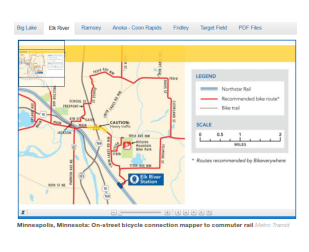On February 25, the NEOSCC Board will be voting on the the Vibrant NEO 2040 Vision, Framework and Action Products. Everyday over the next 5 weeks, we will be sharing an “Initiative A Day” so you can gain a better understanding of the vision and framework! If you would like to read all of the Initiatives, you can download them here: Recommendation and Initiatives
Show your support for Vibrant NEO 2040 by adding your name to our Champions of Vibrant NEO 2040 list here!
Initiative 6.1: Expand the existing bicycle lane and trail system and connect it to regional transit hubs via on-and-off street facilities.

When combined with a revised set of project selection criteria at the MPO level emphasizing alternative modes in transportation decision-making (refer to Initiative 5.2), an approach based on transit access helps to define a focused strategic direction that increases regional travel choice and ensures that public investment in transportation infrastructure has the farthest-reaching regional benefit for its cost. Being able to access funding at the MPO level unlocks opportunities for making these kinds of connections to transit facilities.
Taking on this initiative may also involve identifying the key transit hubs for which bicycle investment needs to be prioritized. This in turn may involve coordination of transit service so that hubs of regional significance can be defined. (Refer to Initiatives 4.1 and 4.2, which discuss investment in a regional system of core connecting routes between major economic centers and service enhancements along these routes and other high-performing transit routes.) It also means defining clear policies and design guidance on how bicycles will be accommodated at the end of the biking trip. In general, urban buses throughout the United States are equipped with on-vehicle bicycle racks to allow bicycle riders accessing transit service to carry bicycles with them. This approach has capacity limitations that are directly related to the frequency of service provided. Transit agencies, local governments, and other partner organizations can invest in bicycle parking and storage facilities that increase the ability of transit service to serve patrons connecting by bicycle.
WHY THIS IS IMPORTANT: Bicycles are a form of connecting to transit service that is underutilized in Northeast Ohio communities. Due to the greater travel speeds they offer, they can extend the potential reach of transit stations from the half-mile distances comfortable for pedestrians up to three miles in the same 10-minute travel time. Since these bicycle links are still comparably short distances compared to an overall commute trip, weather issues do not significantly limit these trips. As a result, bicycling enables potential increases in transit ridership without a need for corresponding investment in road projects or additional connecting transit service. Many communities have provided demonstrable benefits with respect to mobility and accessibility though resourceful and incremental additions to the bicycle network. Bicycle lanes may be striped on a street with a wide outer lane when that street is being resurfaced, or individual travel lane widths may be reduced across the street’s width to fit bicycle lanes.
This initiative is a useful investment that is likely to offer even greater benefit as cycling increases in the future. National Household Travel Survey data have shown an increase of nearly 50 percent in cycling as a commuting travel mode between 2001 and 2009 (citation: TCRP Report 163, Guidelines for Providing Access to Public Transportation Stations, p.66). Although the size of the Northeast Ohio region may not readily facilitate commuting exclusively by bicycle, strategic actions would connect local and regional bicycle networks to the transit service envisioned in Recommendation 4 and its supporting initiatives.
GETTING IT DONE: This initiative should be led by Northeast Ohio’s MPOs, in close collaboration with local jurisdictions where proposed connections would occur. MPOs are best positioned to scope and secure funding for a regional corridor and connection identification process, and prioritize projects for construction utilizing their established committees and procedures. MPOs should engage key implementing partners and stakeholders, including local jurisdictions and Metroparks authorities. Funding for planning work can be secured through normal MPO funding channels, or via discretionary grant applications, such as the Federal Highway Administration’s (FHWA) Transportation, Community, and System Preservation (TCSP) program.
Lead |
Nonprofit Organizations; Metropolitan Planning Organizations; Metroparks Authorities; Municipalities, Counties |
Target Community |
Strategic investment areas, asset risk areas, cost risk areas |
Implementation Complexity |
Low |
These recommendations, initiatives, and products, are not one-size-fits all and some aspects of the initiatives won’t be applicable everywhere in the 12-county region. The Vibrant NEO 2040 Vision, Framework and Products are intended inspire and guide decision-making at the Metropolitan Planning Organization (MPO), Council of Government, and local levels to ensure that land use, transportation, and environmental considerations are simultaneously addressed by their processes. Ultimately, the implementation of Vibrant NEO 2040 is up to Northeast Ohio’s communities and residents. But regardless of the applicability of each initiative to any particular part of the region, the goal for each community within the Vision is the same: stability, prosperity, and a high quality of life for all of its residents.
